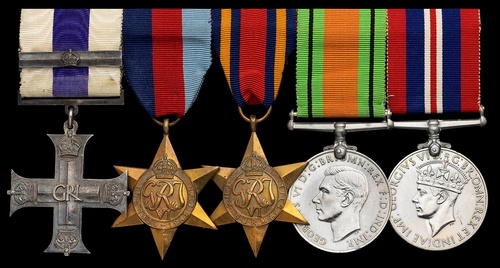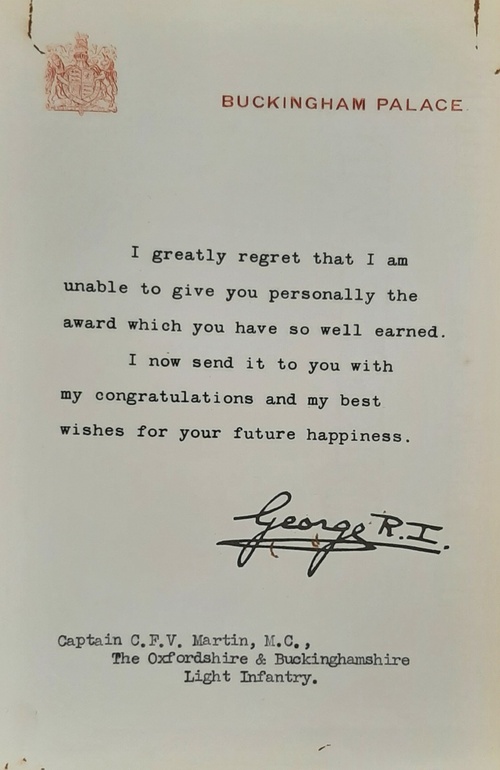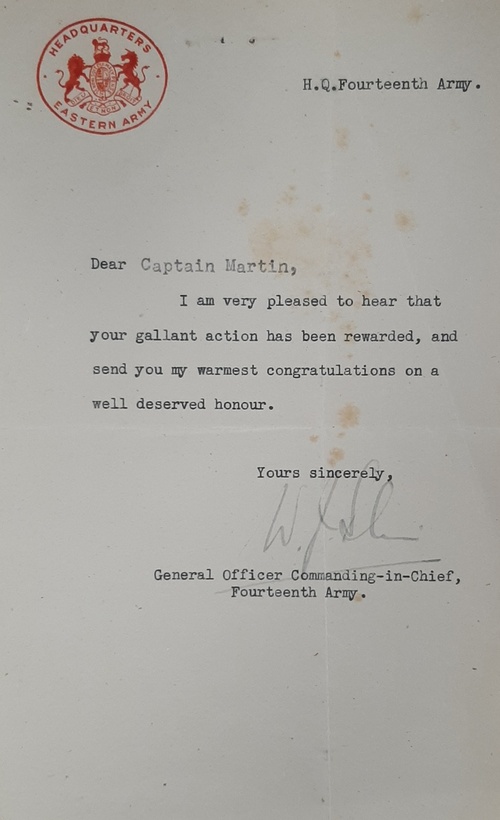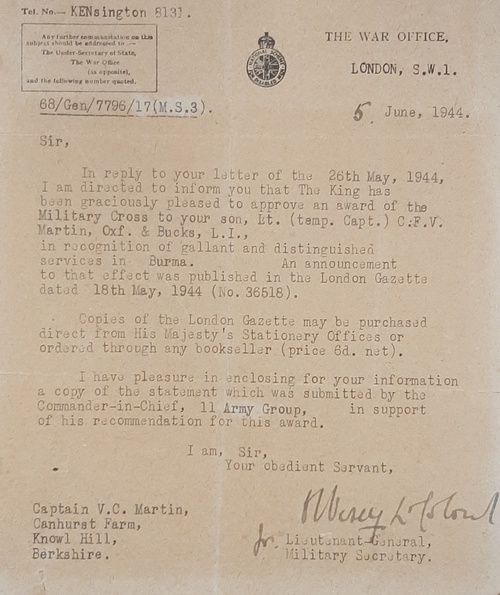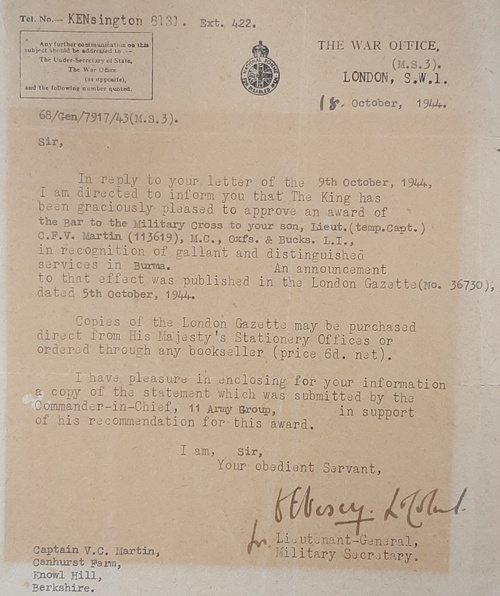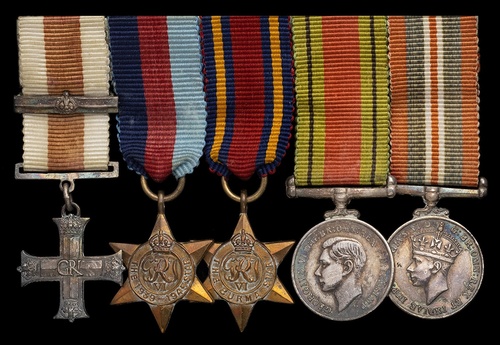Auction: 25001 - Orders, Decorations and Medals
Lot: 344
(x) The rare and remarkable 'Tiddim Defence of Point 6052' M.C. and 'Battle of Imphal' Second Award Bar group of five awarded to Captain C. F. V. Martin, Oxfordshire and Buckinghamshire Light Infantry
Military Cross, G.VI.R., the reverse dated '1944', with Second Award Bar dated 1944; 1939-1945 Star; Burma Star; Defence Medal; War Medal 1939-45, mounted for wear, sold together with the named Buckingham Palace forwarding slip for the Military Cross and Second Award Bar and a further archive, good very fine (5)
M.C. London Gazette 18 May 1944, the original recommendation states:
'While in command of a company on pt. 6052 on the 26th of January 1944, the enemy put in a persistent attack from 1745 hours to 1830 hours, which was repulsed with heavy losses. At 2300 hours the enemy again attacked with even more determination but was again driven back. During both these attacks, Captain Martin ran from post to post in the open, directing the fire and encouraging the men, regardless of his personal safety. Throughout the 27th and the 28th, the enemy sent frequent harassing parties to wear down our defences and to prevent our men from sleeping. On the 29th of January, our position was again very heavily attacked, this time by two enemy companies, from 0530 hours to 1030 hours. Although the position was thinly held, our casualties equivalent to one platoon, and the men tired through three sleepless nights, the enemy was driven back time and again with very heavy losses estimated at 200 killed and wounded. Although completely without sleep during these four days, Captain Martin went from trench to trench, encouraging the men and urging them to hold on, despite close range grenade, small arms and very heavy mortar fire. When the enemy broke through the wire and threatened to swamp the defences, he personally organised and led a counterattack which, by determined hand to hand fighting wiped out all the enemy who had broken in. Captain Martin's splendid example of personal gallantry and leadership in the face of heavy odds, his spirit of endurance and determination to hold out, inspired all ranks to resist at all costs, over a period of four days, a persistent enemy attempt to capture a position of extreme tactical significance'
Second Award Bar London Gazette 5 October 1944, the original recommendation states:
'On the morning of the 26th of May 1944, Captain Martin was leading a Company taking part in the attack on Red Hill RK 224488.
In the initial stages of this attack Captain Martin was wounded leading his Company under heavy MMG fire on to the objective, but ignoring his wounds this officer personally led a grenade throwing party to wipe out a Japanese Bunker, which was holding up the advance of his company. With complete disregard for his own safety and despite his wounds this officer approached the bunker, the occupants of which had been catching our grenades and throwing them back, and by waiting 3 seconds after the cap of the grenade had been struck before he threw it, succeeded in wiping out the bunker and thereby clearing the way for the advance. In doing this Captain Martin was again wounded, but continued to lead his Company forward until he collapsed from loss of blood.
This magnificent example of gallantry and selfless devotion to duty under heavy fire was not only a supreme inspiration to every man in the Company, but a vital contributory factor in the success of the attack.'
Clifford Frederick Victor Martin was born in Oxfordshire on 17 July 1919, the son of Captain Victor and Rose Martin. Granted a Regular Army Emergency Commission and gazetted as a 2nd Lieutenant with the number 113619, he joined the Oxfordshire and Buckinghamshire Light Infantry on 16 January 1940.
Martin then saw service out in India and Burma when on attachment to the Indian Army and serving with the 7th Battalion, 10th Baluch Regiment. He likely received his attachment to the 7th Battalion in the aftermath of the retreat from Burma in 1942, during which the Battalion had formed part of the 46th Indian Brigade in the 17th Indian Division. After withdrawing from Burma, the 17th Division then found itself stationed in Assam.
They were not part of the failed First Arakan Offensive of late 1942 into the spring of 1943, but instead undertook intensive training to learn from the mistakes of the previous year in readiness to take the offensive against the Japanese in 1944 and 1945.
The Defence of Point 6052
Their first major operation occurred in January 1944, and it was Martin - then commanding a composite formation of 'A' and 'C' companies - who bore the brunt of it. It was for this period while serving as a temporary Captain that he was awarded the Military Cross for his gallantry during the defence of Point 6052.
Martin's composite company was established on Point 6052, seven miles south of Tiddim, to form a patrol base. They launched several patrols to engage and identify the Japanese in the area and the perimeter of the base was at one point attacked but the company was able to hold on. This attack occurred on 26 January 1944, the day Martin earned his first Military Cross.
It was estimated that the 7/10th Baluch killed more than 200 Japanese in the area, while themselves suffering only 3 killed and 10 wounded over the course of the month. The positions were dug in all round defences on ground of the 7/10th Baluch's choosing. This enabled them to repel the Japanese attacks, unlike at Pa-an in 1942, and showed that the retraining of the past 18 months had paid dividends.
In the aftermath of his honour, Martin received a personal letter from General Slim, commander of the 14th Army, stating: 'I am very pleased to hear that your gallant action has been rewarded, and sent you my warmest congratulations on a well deserved honour.'
The Battalion continued to send out patrols in the areas in front of and around Point 6052 in February and March, with the men and officers gaining valuable experience in operating as light infantry during this period. The Battalion, along with the 4/12th Frontier Force Rifles, withdrew along the Tiddim Road on 4 April in the face of increasing pressure during the Japanese advances and the repositioning in readiness for the Battle of Imphal.
Imphal
Having retreated onto the Imphal Plain, they were sent to protect the Panel airstrip. The Battalion took over positions in the 'Catfish Box' area on 5 April, also at this point receiving reinforcements to create a fourth company and bring it up to strength as an ordinary infantry unit.
A Company, under the command of now acting-Major Martin, was sent to Point 5846 on the Bishenpur-Silchar Road while the rest of the Battalion took the opportunity to re-organise and to incorporate the new company. The 7/10th Baluch moved to the 17th Divisional Box at Chingphu, north of Bishenpur, in mid-May as a response to increased Japanese pressure on the entrance to the Imphal Plain from the Bishenpur region.
Red Hill Pimple
They began to dig in immediately upon arrival in their capacity as a protection of the divisional HQ. A series of patrols were sent out around the area as reports arrived of Japanese forces coming from the west, and a major clash ensued on 20 May involving one platoon on a ridge overlooking the divisional area. This force managed to hold out for more than 8 hours and successfully held up a major Japanese group. On 25th May, the Battalion was ordered to carry out an attack on Point 2926, 'Red Hill Pimple'. That evening, 3 Companies - A, B and C, respectively - moved to their jumping off positions, which included the ridge itself, without being heard or noticed by the Japanese.
The A and C Companies were to attack the Japanese bunker positions from the ridge, while B Company was tasked with seizing the village on the west side of the ridge. The attack went in at 04:30 hours on 26 May. The first Japanese positions were destroyed, but a second layer of bunkers held up both attacks. The attackers dug in for fear of a Japanese counterattack, and after a day of holding areas of the ridge and village, withdrew to the divisional HQ box after the Japanese pulled back from the hill. The Battalion had been able to not only approach the Japanese but also to mount an attack without being detected in any way. Any Japanese soldier on the ridge who was familiar with Pa-an would probably have been surprised that this was the same unit.
Martin was awarded the Second Award Bar to his Military Cross for his gallantry during this engagement on 26 May 1944. His Battalion suffered three officers and 26 other ranks killed, and close to 100 were wounded from the period of 25 to 27 May, one of whom was Martin, who was twice wounded in the fighting on 26 May. Around this time, Martin's father was residing at Canhurst Farm, Knowl Hill, Berkshire, as evidence by surviving documentation concerning his son's awards.
After the engagement they carried out patrols in and around the divisional box area. Throughout June and early July, the battalion shifted back and forth between the control of the 63rd and 48th Brigades, continuing regardless of which formation was in control, to send out long term patrols and set up box formations throughout the region. On a few occasions, such as Evans' Knob during the first week of July, troops were involved in heavy fighting. For his part Martin would have been evacuated for treatment owing to his wounds. He is interestingly recorded twice in Casualty Lists for his wounds, with one dated 22 June and the other 26 June 1944, and one wonders if he may also have been very slightly wounded on 22 June. He subsequently gave an interview about this action, which was recorded on 12 January 2000.
Epilogue
Martin married Ridley Alice Mary Fry and they went on to live together in Henley-on-Thames, Oxfordshire. He died in Wokingham, Berkshire on 5 December 2003; sold together with copied research and an original archive comprising:
i)
Military Cross original typed citation.
ii)
War Office letter notifying Martin's father of the award of the Bar to the Military Cross to his son, issued in response to his letter of 9th October 1944, and enclosing a copy of the statement which was submitted by the Commander-in-Chief of the 11th Army Group in support of his recommendation for the award. Dated 18th October 1944, and addressed to Captain V.C. Martin, Canhurst Farm, Knowl Hill, Berkshire.
iii)
Second Award Bar to the Military Cross original typed citation.
iv)
City of London Worshipful Company of Vintners Liveryman's Silver Medal, silver, medallists initials 'W.J.D.' for William James Dingley, and hallmarks for Birmingham with date letter 'P' for 1939, reverse engraved: 'Clifford F.V. Martin. 18th: June 1941', this housed in its fitted presentation case by Birch and Gaydon Ltd, Watchmakers to the Admiralty, Diamond Merchants and Jewellers, 153 Fenchurch St., London'.
v)
Letter to Captain Martin from General William Joseph Slim, later Field Marshal K.G., G.C.B., G.C.M.G., G.C.V.O., G.B.E., D.S.O., M.C., K.St.J, this sent from the Headquarters of the Fourteenth Army, undated, issued on Headquarters Eastern Army headed paper, and reading 'I am very pleased to hear that your gallant action has been rewarded, and sent you my warmest congratulations on a well deserved honour.' Signed in ink, 'W.J. Slim' as General Officer Commanding-in-Chief, Fourteenth Army.
Subject to 5% tax on Hammer Price in addition to 20% VAT on Buyer’s Premium.
Estimate
£2,400 to £2,800
Starting price
£1900

